Effect of Multiple Injection Strategy Under High Ammonia Ratio on Combustion and Emissions of Liquid Ammonia/Diesel Dual DI Engine
Abstract
1. Introduction
2. Numerical Model and Method
2.1. Engine Specifications and Computational Model Selection
2.2. Grid Sensitivity and Model Validation
2.3. Multiple Injection Control Method
3. Results and Discussion
3.1. Effects of Times of Injection
3.1.1. Combustion Characteristics
3.1.2. Emission Characteristics
3.2. Optimization of Spray Strategy
3.2.1. Advance Ammonia Injection Timing
3.2.2. Effect of Ammonia Injection Pressure
4. Conclusions
- Using multiple injection can have a negative effect on the combustion of liquid ammonia injected later, but with an increase in the TSOI, this situation will be improved to some extent. With the increase of TSOI, the peak cylinder pressure stage is advanced, CA10 is advanced, the combustion duration is shortened, and the combustion speed is relatively faster than a single injection. Increasing TSOI will reduce GHG emissions and overall NOx emissions, but unburned NH3 emissions will increase. TSOI = 2, with the lowest N2O emissions at 1.38 ppm; TSOI = 3, with the lowest NOx emissions at 107.61 ppm.
- Advancing the SOAI timing to −8 °CA ATDC leads to earlier injection of ammonia, allowing it to interact more effectively with the diesel-dominated combustion process, thereby improving overall combustion efficiency. The peak cylinder pressure has significantly increased, and the peak phase shifts forward as TSOI increases, but oscillates within a certain range. Advancing the SOAI timing has an improvement effect on later combustion. When TSOI = 2, the heat release shows a clear bimodal pattern, while the heat release rate at SOAI = −0.5 °CA ATDC only shows a unimodal pattern. The overall N2O and NOx emissions have increased, while unburned NH3 emissions have decreased. But when SOAI advanced to −8 °CA ATDC, NOx showed a decreasing trend with the increase of TSOI, and the reduction was not small. When TSOI = 3, NOx emissions reached their lowest point, which was more than 50% lower than a single ammonia injection.
- Increasing the injection pressure of ammonia can enhance its contact with the mixed gas and promote combustion. When TSOI = 2, increasing AIP from 50 MPa to 150 MPa increases the peak cylinder pressure, and there is a significant increase in the peak heat release dominated by ammonia, but only a single peak, indicating that increasing AIP alone cannot achieve multi-stage heat release. N2O emissions increase with the increase of AIP, which is due to more ammonia participating in the oxidation reaction, while CO2, NOx, and NH3 emissions, although changing, are small.
Author Contributions
Funding
Institutional Review Board Statement
Informed Consent Statement
Data Availability Statement
Conflicts of Interest
Nomenclature
| ADDF | Ammonia diesel dual fuel |
| AER | Ammonia energy ratio |
| AIP | Ammonia injection pressure |
| ATDC | After the top dead center |
| CA | Crank angle |
| CA10 | Crank angle corresponding to 10% of the total heat release rate |
| CA50 | Crank angle corresponding to 50% of the total heat release rate |
| CA90 | Crank angle corresponding to 90% of the total heat release rate |
| CI | Compression ignition |
| CO | Carbon monoxide |
| DI | Direct injection |
| GHG | Greenhouse gas |
| HRR | Heat release rate |
| ITE | Indicated thermal efficiency |
| NOx | Nitrogen oxides |
| N2O | Nitrous oxide |
| SOAI | State of ammonia injection |
| SODI | Start of diesel injection |
| TDC | Top dead center |
| TSOI | The times of injection |
References
- Chen, Y.; Zhang, J.; Zhang, Z.; Zhang, B.; Hu, J.; Zhong, W.; Ye, Y.J. A comprehensive review of stability enhancement strategies for metal nanoparticle additions to diesel/biodiesel and their methods of reducing pollutant. Process Saf. Environ. Prot. 2024, 183, 1258–1282. [Google Scholar] [CrossRef]
- Deng, S.; Mi, Z. A review on carbon emissions of global shipping. Mar. Dev. 2023, 1, 4. [Google Scholar] [CrossRef]
- Wu, Z.; Huang, X.; Chen, R.; Mao, X.; Qi, X.J. The United States and China on the paths and policies to carbon neutrality. J. Environ. Manag. 2022, 320, 115785. [Google Scholar] [CrossRef] [PubMed]
- Chen, G.; Wei, F.; Zhang, K.; Xiao, R.; Wang, Z.; Yang, S.J. Investigation on combustion characteristics and gas emissions of a high-pressure direct-injection natural gas engine at different combustion modes. Energy Convers. Manag. 2023, 277, 116617. [Google Scholar] [CrossRef]
- Dong, D.; Wei, F.; Long, W.; Dong, P.; Tian, H.; Tian, J.; Wang, P.; Lu, M.; Meng, X.J. Optical investigation of ammonia rich combustion based on methanol jet ignition by means of an ignition chamber. Fuel 2023, 345, 128202. [Google Scholar] [CrossRef]
- Frost, J.; Tall, A.; Sheriff, A.M.; Schönborn, A.; Hellier, P. An experimental and modelling study of dual fuel aqueous ammonia and diesel combustion in a single cylinder compression ignition engine. Int. J. Hydrogen Energy 2021, 46, 35495–35510. [Google Scholar] [CrossRef]
- Dimitriou, P.; Javaid, R. A review of ammonia as a compression ignition engine fuel. Int. J. Hydrogen Energy 2020, 45, 7098–7118. [Google Scholar] [CrossRef]
- Kurien, C.; Mittal, M. Review on the production and utilization of green ammonia as an alternate fuel in dual-fuel compression ignition engines. Energy Convers. Manag. 2022, 251, 114990. [Google Scholar] [CrossRef]
- Gill, S.; Chatha, G.; Tsolakis, A.; Golunski, S.E.; York, A.J.E. Assessing the effects of partially decarbonising a diesel engine by co-fuelling with dissociated ammonia. Int. J. Hydrogen Energy 2012, 37, 6074–6083. [Google Scholar] [CrossRef]
- da Rocha, R.C.; Costa, M.; Bai, X.-S. Chemical kinetic modelling of ammonia/hydrogen/air ignition, premixed flame propagation and NO emission. Fuel 2019, 246, 24–33. [Google Scholar] [CrossRef]
- Shin, J.; Park, S. Numerical analysis and optimization of combustion and emissions in an ammonia-diesel dual-fuel engine using an ammonia direct injection strategy. Energy 2024, 289, 130014. [Google Scholar] [CrossRef]
- Niki, Y.; Nitta, Y.; Sekiguchi, H.; Hirata, K. Diesel fuel multiple injection effects on emission characteristics of diesel engine mixed ammonia gas into intake air. J. Eng. Gas Turbines Power 2019, 141, 061020. [Google Scholar] [CrossRef]
- Zhang, Z.; Long, W.; Dong, P.; Tian, H.; Tian, J.; Li, B.; Wang, Y. Performance characteristics of a two-stroke low speed engine applying ammonia/diesel dual direct injection strategy. Fuel 2023, 332, 126086. [Google Scholar] [CrossRef]
- Li, T.; Zhou, X.; Wang, N.; Wang, X.; Chen, R.; Li, S.; Yi, P. A comparison between low-and high-pressure injection dual-fuel modes of diesel-pilot-ignition ammonia combustion engines. J. Energy Inst. 2022, 102, 362–373. [Google Scholar] [CrossRef]
- Zhou, X.; Li, T.; Wang, N.; Wang, X.; Chen, R.; Li, S. Pilot diesel-ignited ammonia dual fuel low-speed marine engines: A comparative analysis of ammonia premixed and high-pressure spray combustion modes with CFD simulation. Renew. Sustain. Energy Rev. 2023, 173, 113108. [Google Scholar] [CrossRef]
- Liu, L.; Wu, Y.; Wang, Y. Numerical investigation on the combustion and emission characteristics of ammonia in a low-speed two-stroke marine engine. Fuel 2022, 314, 122727. [Google Scholar] [CrossRef]
- Liu, J.; Liu, J. Experimental investigation of the effect of ammonia substitution ratio on an ammonia-diesel dual-fuel engine performance. J. Clean. Prod. 2024, 434, 140274. [Google Scholar] [CrossRef]
- Zhu, J.; Zhou, D.; Yang, W.; Qian, Y.; Mao, Y.; Lu, X. Investigation on the potential of using carbon-free ammonia in large two-stroke marine engines by dual-fuel combustion strategy. Energy 2023, 263, 125748. [Google Scholar] [CrossRef]
- Pei, Y.; Wang, D.; Jin, S.; Gu, Y.; Wu, C.; Wu, B. A quantitative study on the combustion and emission characteristics of an Ammonia-Diesel Dual-fuel (ADDF) engine. Fuel Process. Technol. 2023, 250, 107906. [Google Scholar] [CrossRef]
- Yousefi, A.; Guo, H.; Dev, S.; Liko, B.; Lafrance, S. Effects of ammonia energy fraction and diesel injection timing on combustion and emissions of an ammonia/diesel dual-fuel engine. Fuel 2022, 314, 122723. [Google Scholar] [CrossRef]
- Nadimi, E.; Przybyła, G.; Løvås, T.; Peczkis, G.; Adamczyk, W. Experimental and numerical study on direct injection of liquid ammonia and its injection timing in an ammonia-biodiesel dual injection engine. Energy 2023, 284, 129301. [Google Scholar] [CrossRef]
- Mi, S.; Zhang, J.; Shi, Z.; Wu, H.; Zhao, W.; Qian, Y.; Lu, X. Optimization of direct-injection ammonia-diesel dual-fuel combustion under low load and higher ammonia energy ratios. Fuel 2024, 375, 132611. [Google Scholar] [CrossRef]
- Sun, W.; Zeng, W.; Guo, L.; Zhang, H.; Yan, Y.; Lin, S.; Zhu, G.; Jiang, M.; Yu, C.; Wu, F. An optical study of the combustion and flame development of ammonia-diesel dual-fuel engine based on flame chemiluminescence. Fuel 2023, 349, 128507. [Google Scholar] [CrossRef]
- Førby, N.; Thomsen, T.B.; Cordtz, R.F.; Bræstrup, F.; Schramm, J. Ignition and combustion study of premixed ammonia using GDI pilot injection in CI engine. Fuel 2023, 331, 125768. [Google Scholar] [CrossRef]
- Yousefi, A.; Guo, H.; Dev, S.; Lafrance, S.; Liko, B. A study on split diesel injection on thermal efficiency and emissions of an ammonia/diesel dual-fuel engine. Fuel 2022, 316, 123412. [Google Scholar] [CrossRef]
- Liu, X.; Wang, Q.; Zhong, W.; Jiang, P.; Xu, M.; Guo, B. Optical diagnostics in impact of ammonia energy ratio and diesel split ratio on combustion process and flame propagation in an Ammonia-Diesel Dual-Fuel engine. Fuel 2024, 364, 131074. [Google Scholar] [CrossRef]
- Han, Z.; Reitz, R. Turbulence modeling of internal combustion engines using RNG κ-ε models. Combust. Sci. Technol. 1995, 106, 267–295. [Google Scholar] [CrossRef]
- Reitz, R.D.; Bracco, F.V. Mechanism of breakup of round liquid jets. Encycl. Fluid Mech. 1986, 3, 223–249. [Google Scholar]
- Anthony Amsden, L. A Block-Structured KIVA Program for Engines with Vertical or Canted Valves; Los Alamos National Laboratory (LANL): Los Alamos, NM, USA, 1999. [Google Scholar]
- Schmidt, D.P.; Rutland, C. A new droplet collision algorithm. J. Comput. Phys. 2000, 164, 62–80. [Google Scholar] [CrossRef]
- Amsden, A.A.; O’Rourke, P.J.; Butler, T.D. KIVA-II: A computer program for chemically reactive flows with sprays. Tech. Rep. 1989, 89, 27975. [Google Scholar]
- Senecal, P.; Pomraning, E.; Richards, K.; Briggs, T.; Choi, C.; McDavid, R.; Patterson, M.A. Multi-dimensional modeling of direct-injection diesel spray liquid length and flame lift-off length using CFD and parallel detailed chemistry. SAE Tech. Pap. 2003, 112, 1331–1351. [Google Scholar]
- Anetor, L.; Odetunde, C.; Osakue, E.E. Computational analysis of the extended Zeldovich mechanism. Arab. J. Sci. Eng. 2014, 39, 8287–8305. [Google Scholar] [CrossRef]
- Wang, B.; Dong, S.; Jiang, Z.; Gao, W.; Wang, Z.; Li, J.; Yang, C.; Wang, Z.; Cheng, X. Development of a reduced chemical mechanism for ammonia/ n-heptane blends. Fuel 2023, 338, 127358. [Google Scholar] [CrossRef]
- Khana, S.; Panuab, R.; Bose, P.K. Combined effects of piston bowl geometry and spray pattern on mixing, combustion and emissions of a diesel engine: A numerical approach. Fuel 2018, 225, 203–217. [Google Scholar] [CrossRef]
- Liu, L.; Wu, Y.; Wang, Y. Numerical investigation on knock characteristics and mechanism of large-bore natural gas dual-fuel marine engine. Fuel 2022, 310, 122298. [Google Scholar] [CrossRef]
- Nyongesa, A.J.; Kim, J.K.; Lee, W.-J. Investigation on the combustion of ammonia using direct high/medium-pressure-Otto injection approach in a diesel two-stroke marine slow speed engine. J. Energy Inst. 2024, 114, 101641. [Google Scholar] [CrossRef]
- Xu, X.; Wang, Z.; Qu, W.; Song, M.; Fang, Y.; Feng, L. Optimizations of energy fraction and injection strategy in the ammonia-diesel dual-fuel engine. J. Energy Inst. 2024, 112, 101455. [Google Scholar] [CrossRef]
- Tian, J.; Zhang, X.; Cui, Z.; Ye, M.; Wang, Y.; Xu, T.; Dong, P. Visualization study on ammonia/diesel dual direct injection combustion characteristics and interaction between sprays. Energy Convers. Manag. 2024, 299, 117857. [Google Scholar] [CrossRef]
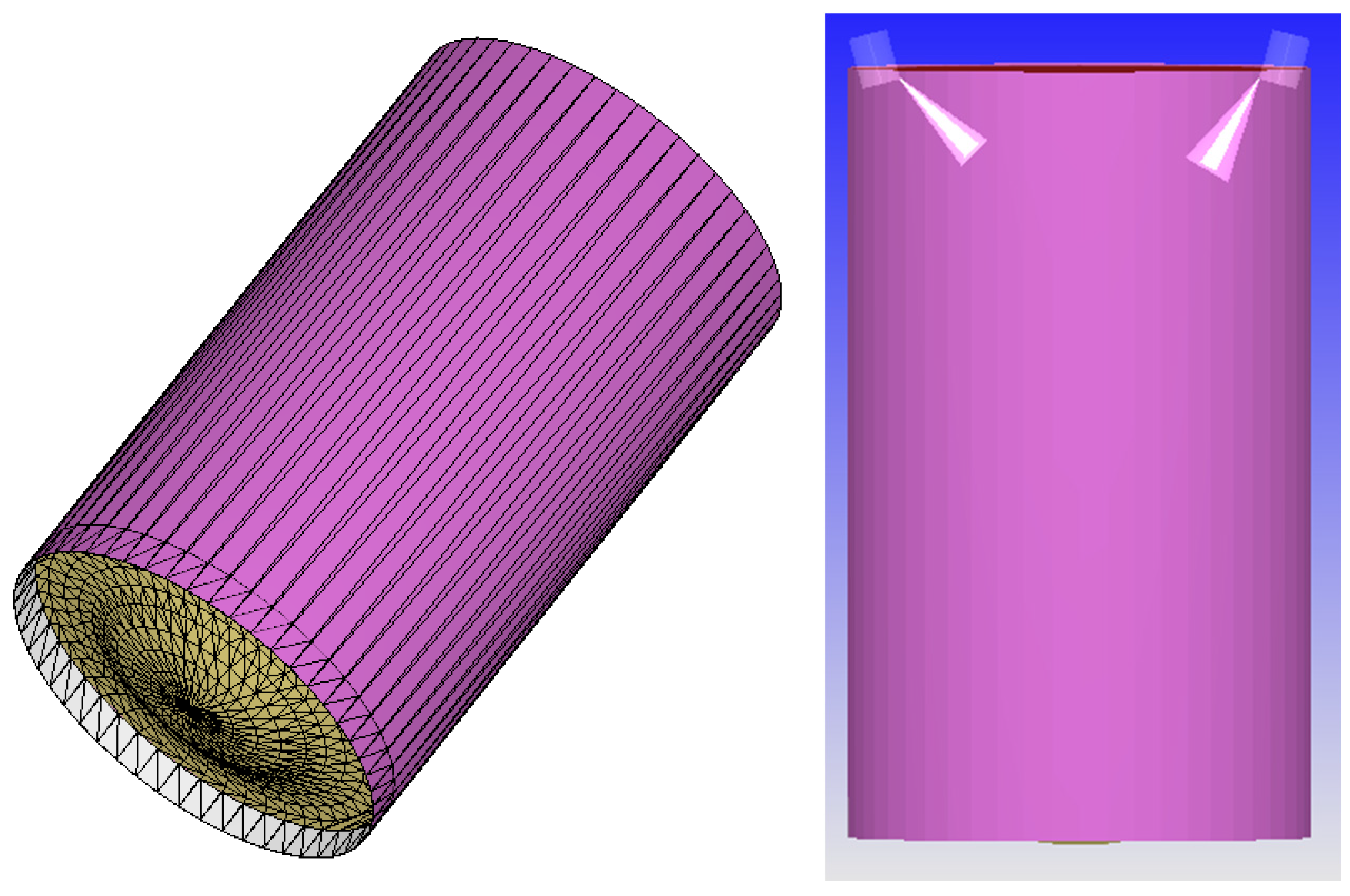
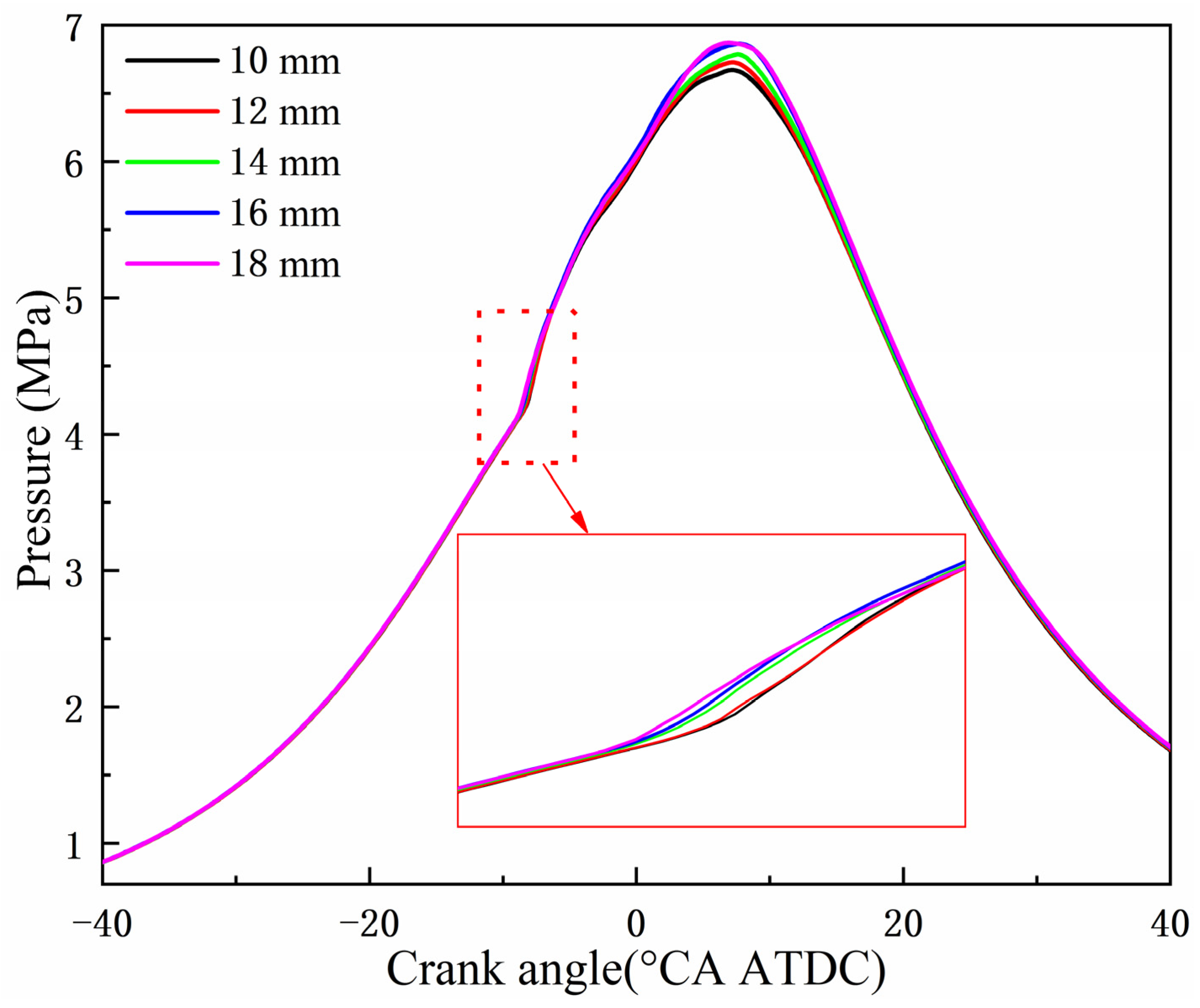
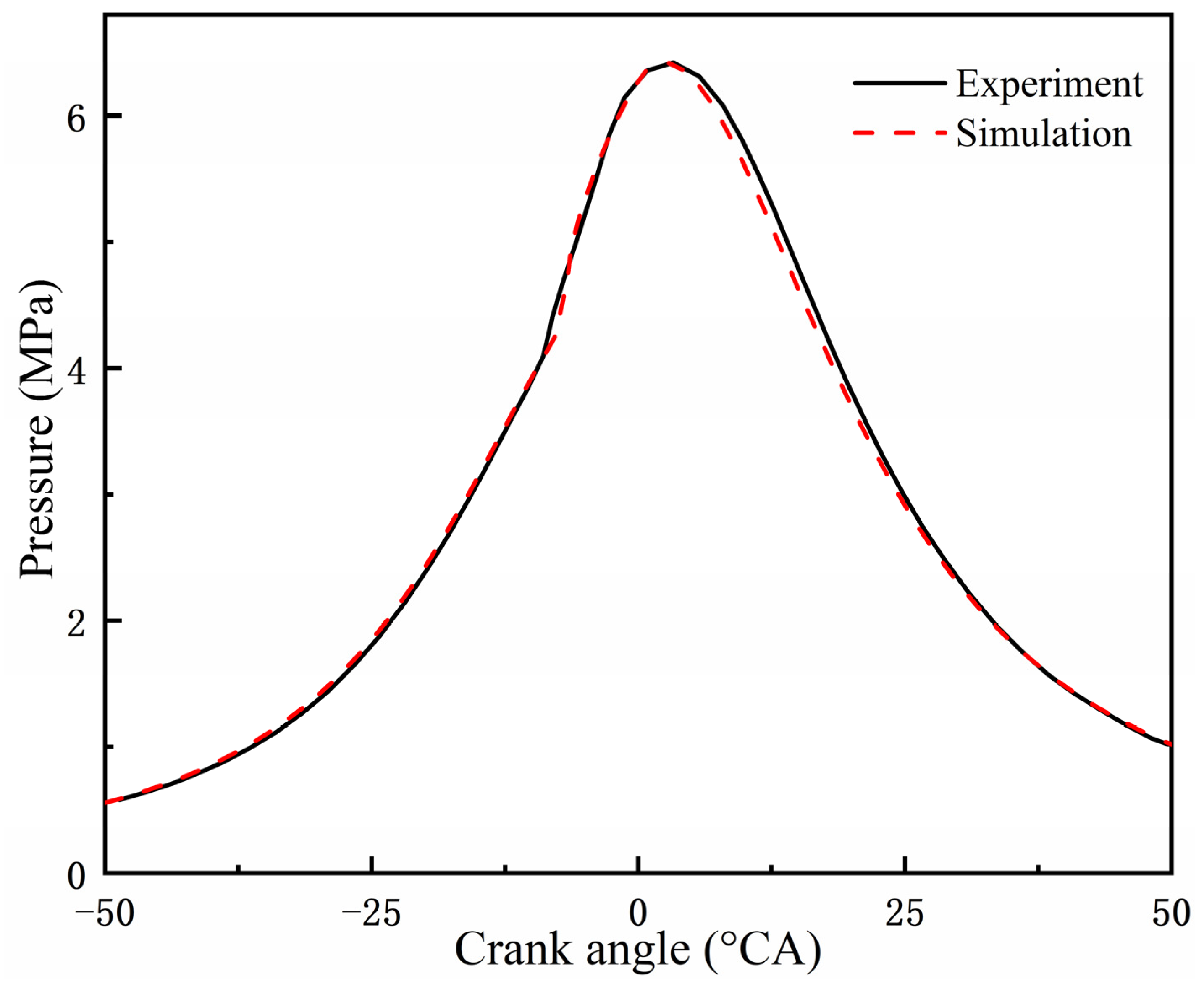
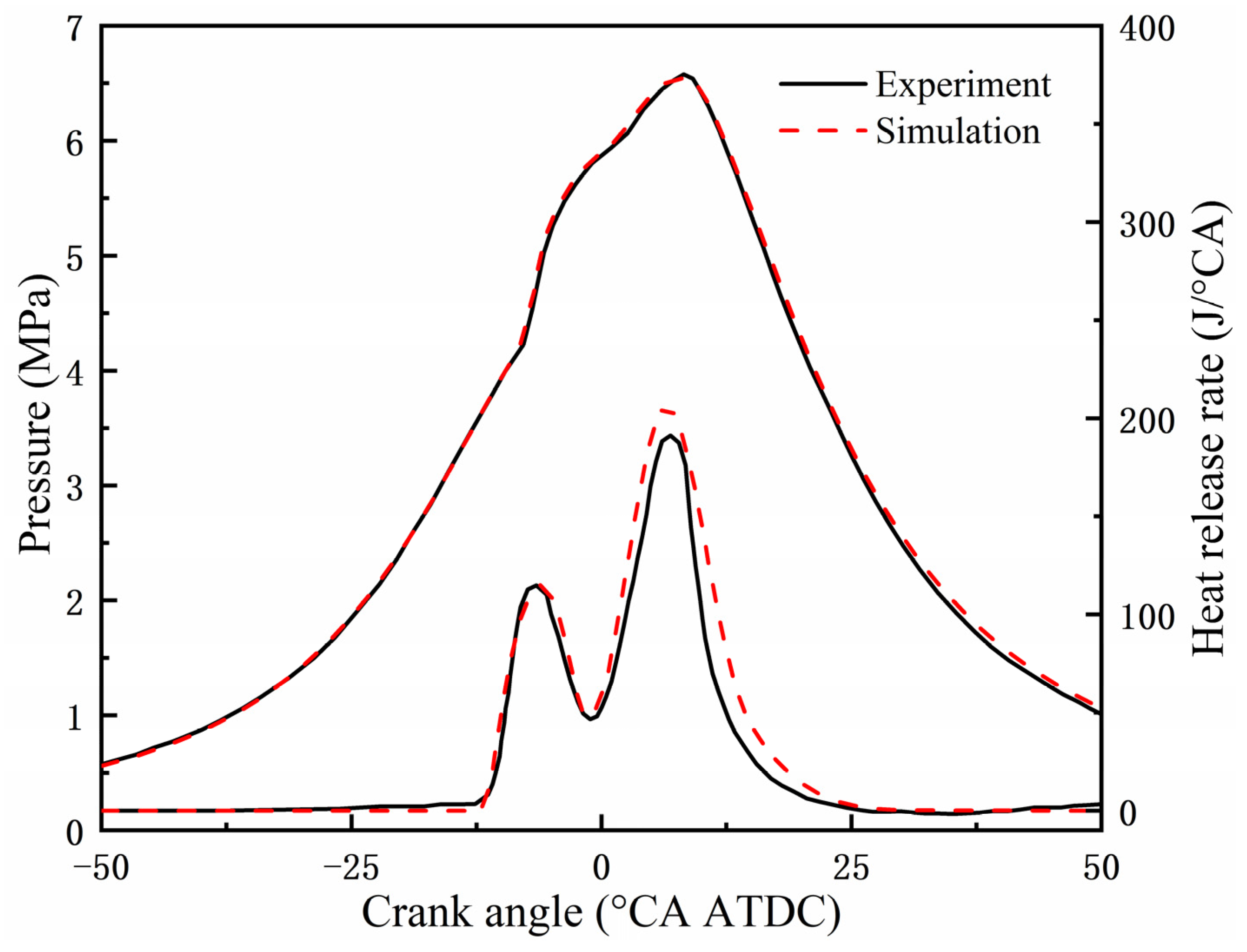
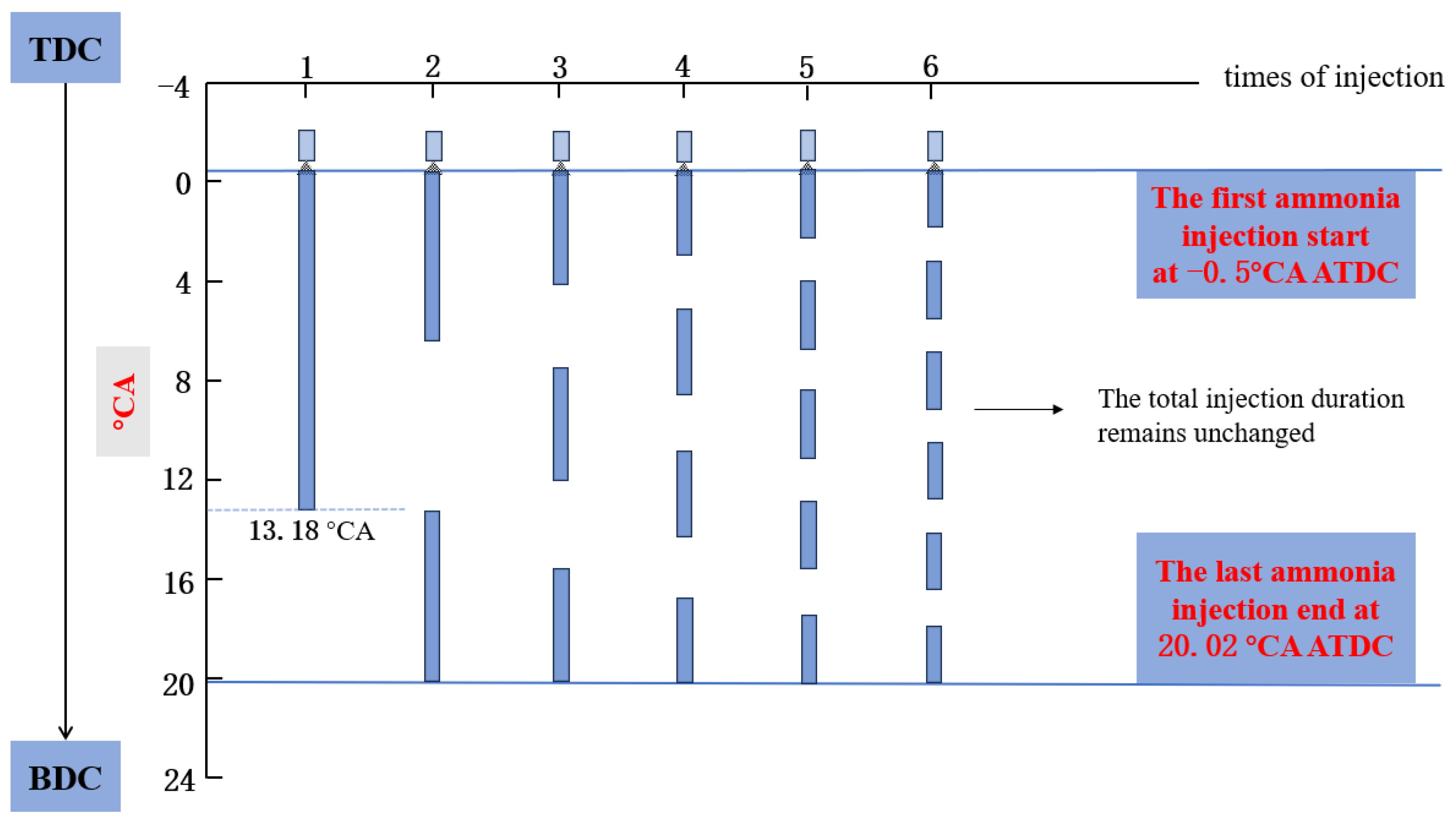
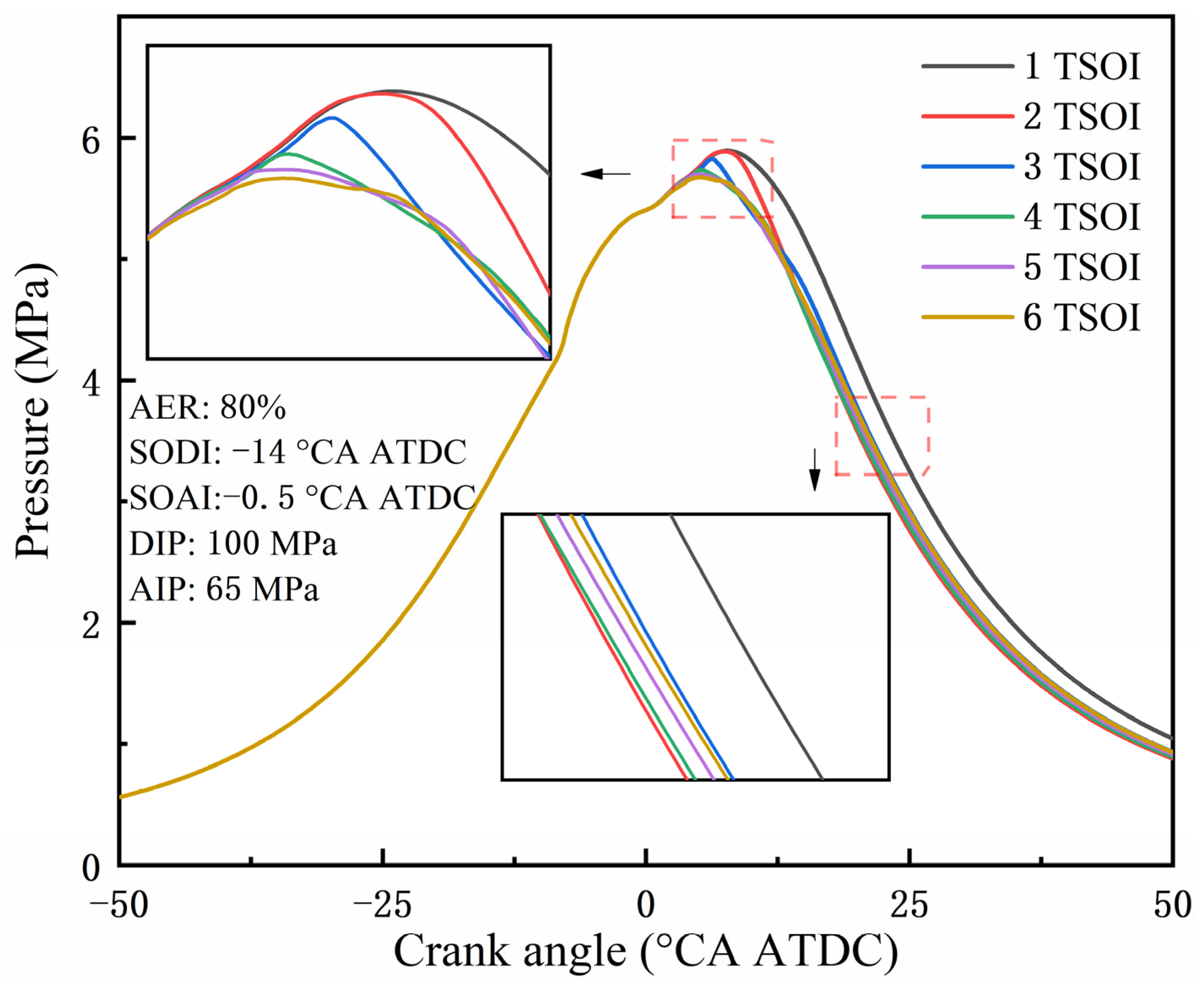
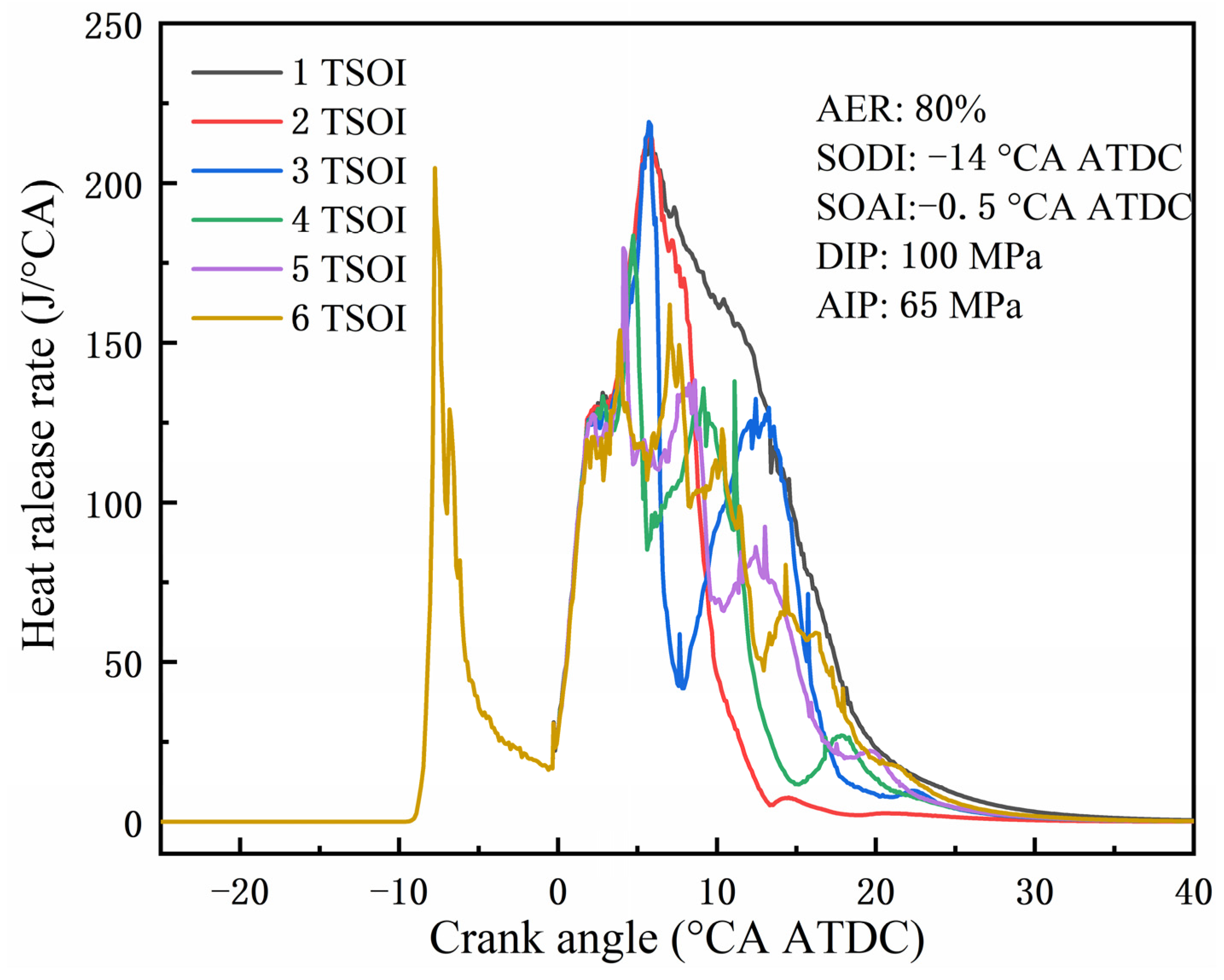


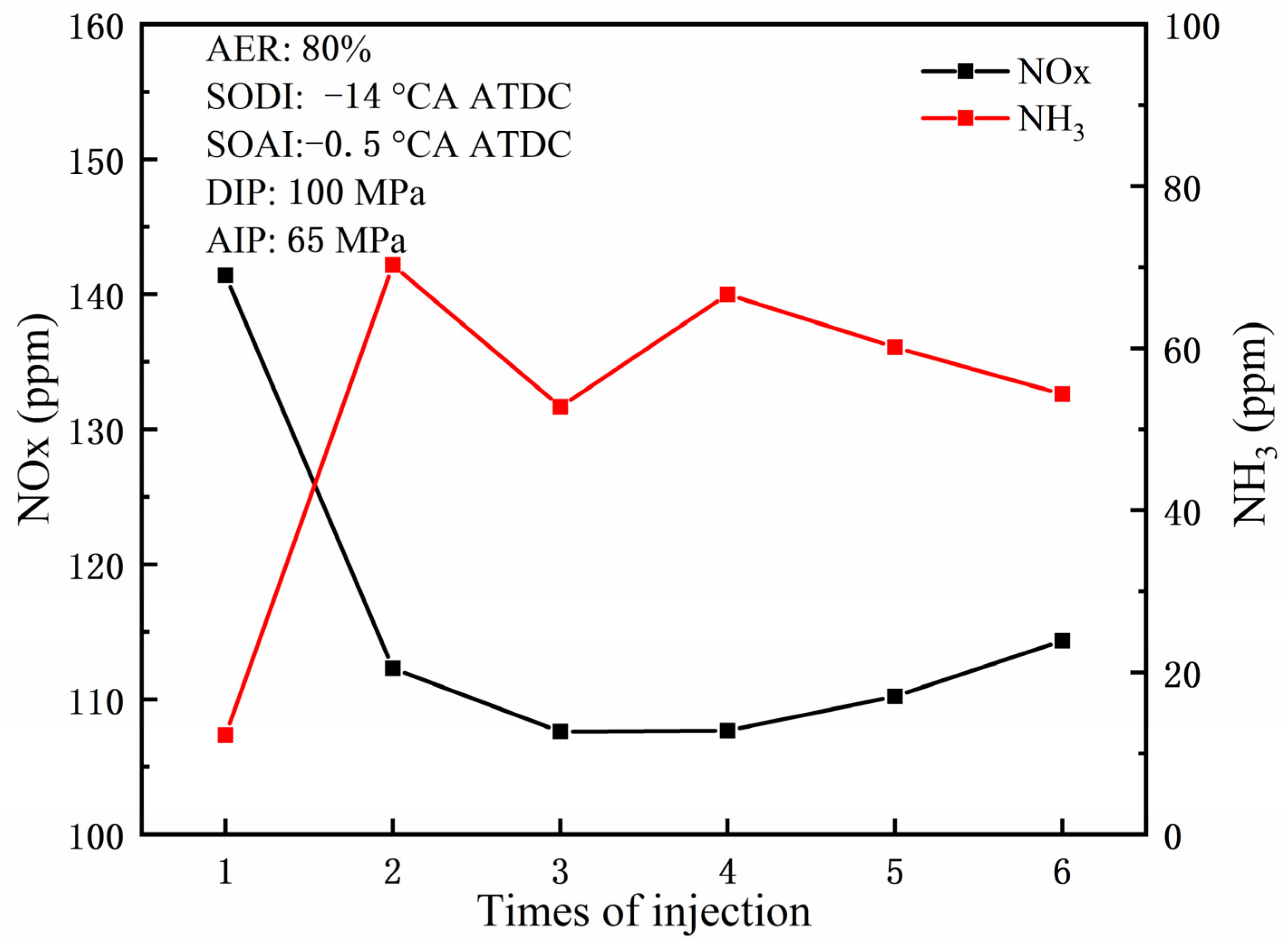


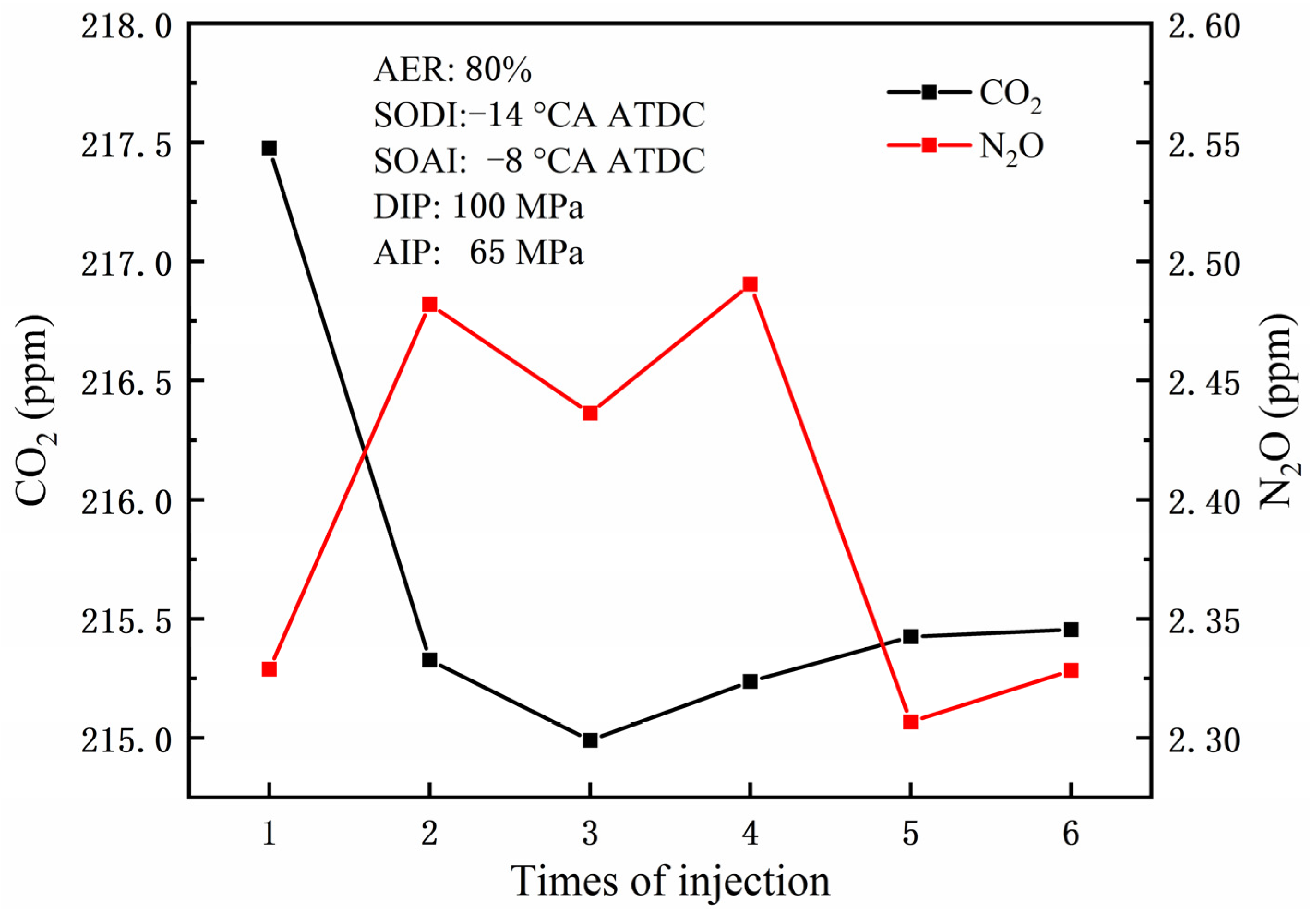
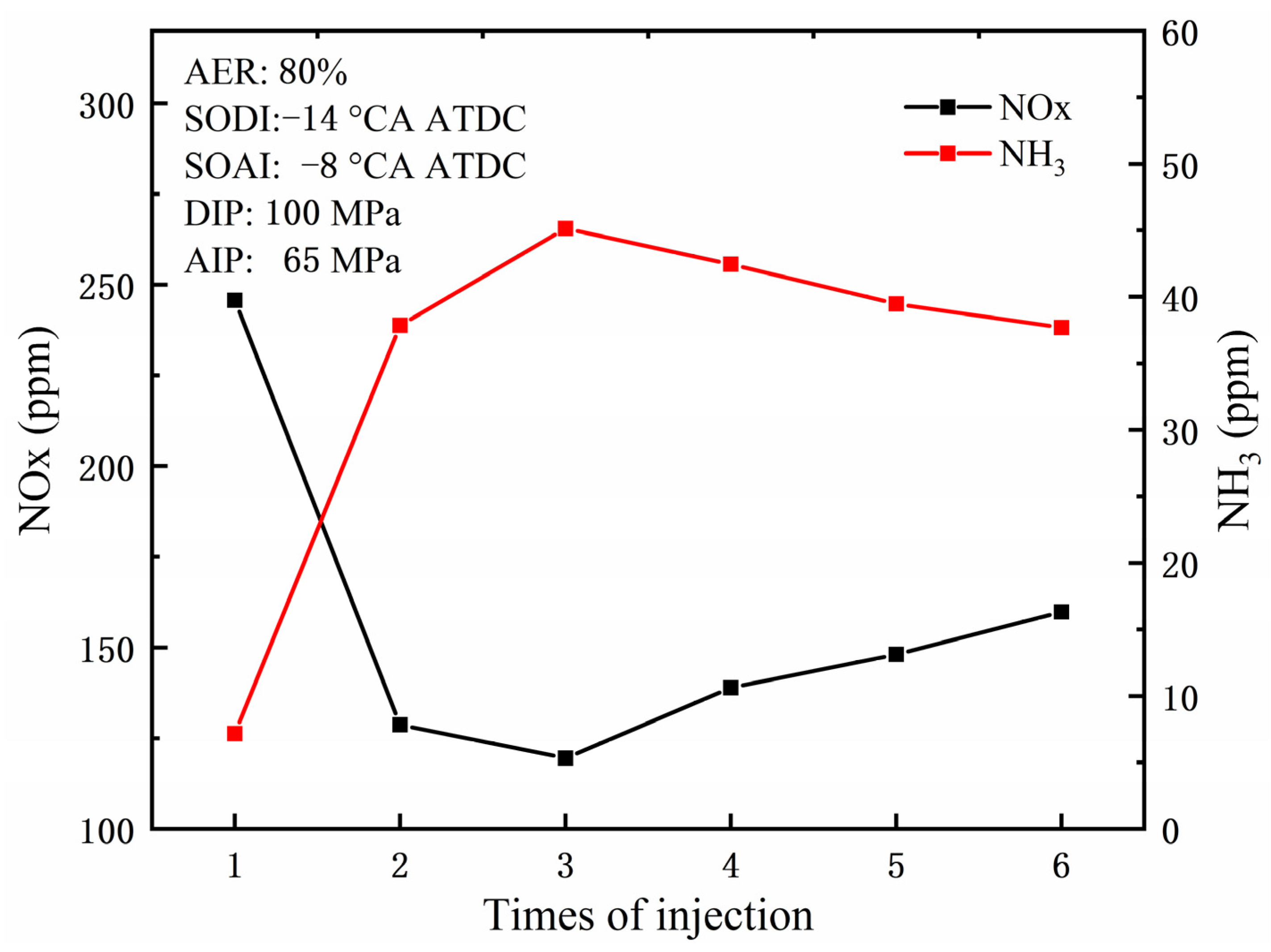
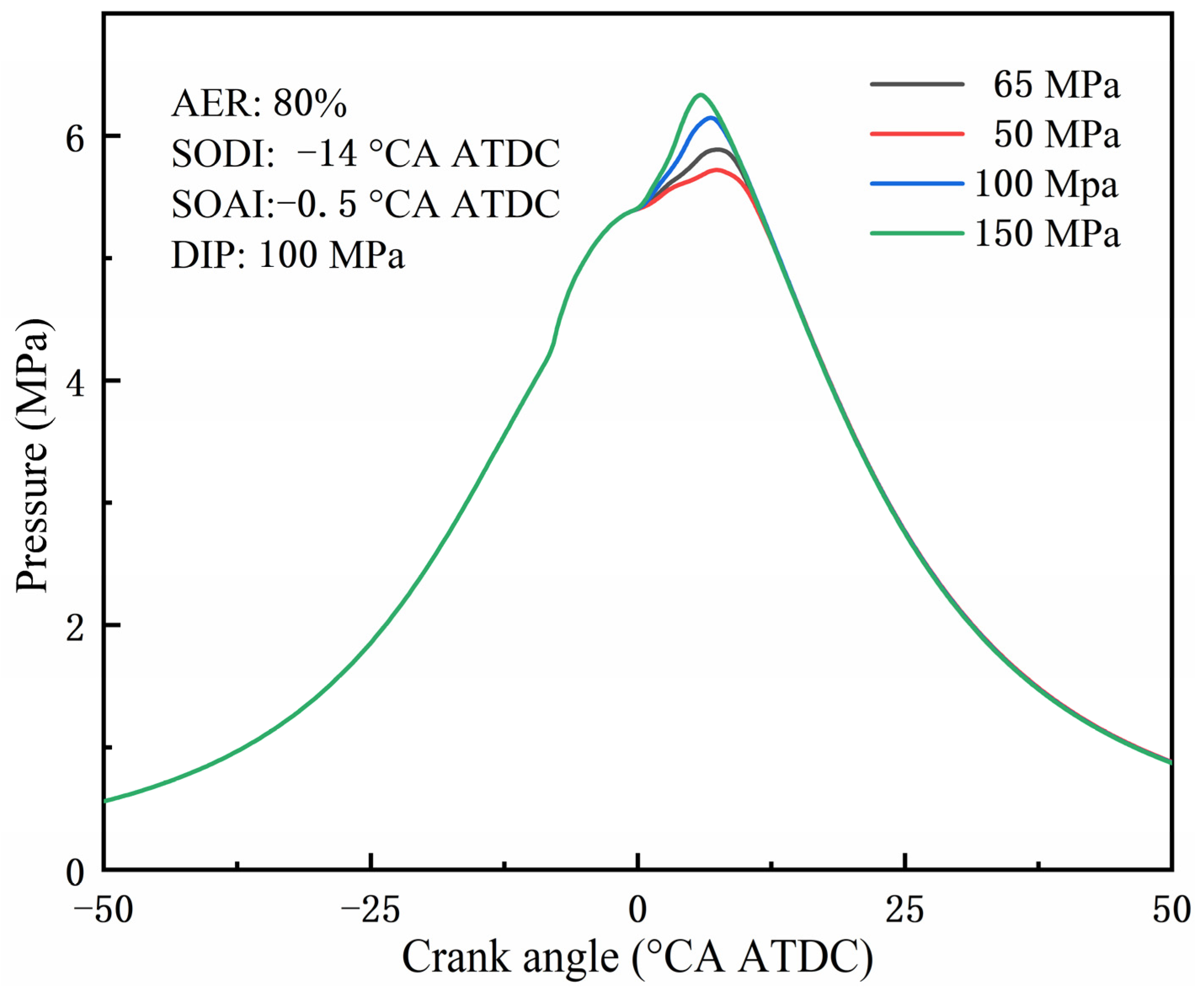

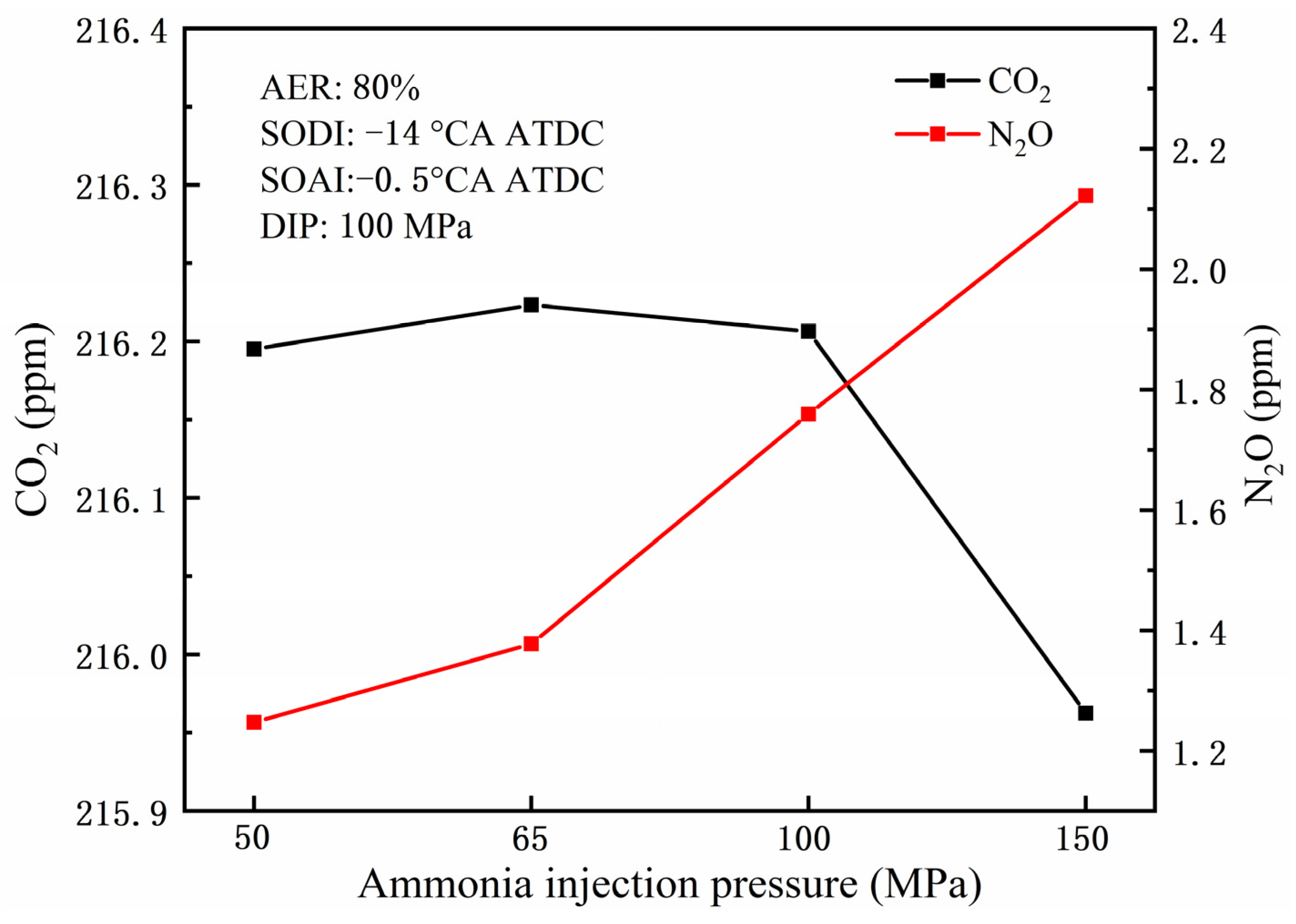

| Parameters | Value |
|---|---|
| Bore and stroke (mm) | 150 × 225 |
| Engine speed (rpm) | 375 |
| Effective compression ratio | 13.8 |
| Ammonia/diesel injection mode | Direct injection in cylinder |
| Ammonia injection pressure (MPa) | 65 |
| Diesel injection pressure (MPa) | 100 |
Disclaimer/Publisher’s Note: The statements, opinions and data contained in all publications are solely those of the individual author(s) and contributor(s) and not of MDPI and/or the editor(s). MDPI and/or the editor(s) disclaim responsibility for any injury to people or property resulting from any ideas, methods, instructions or products referred to in the content. |
© 2025 by the authors. Licensee MDPI, Basel, Switzerland. This article is an open access article distributed under the terms and conditions of the Creative Commons Attribution (CC BY) license (https://creativecommons.org/licenses/by/4.0/).
Share and Cite
Chen, Z.; Wan, Y.; Awad, O.I.; Pan, Z. Effect of Multiple Injection Strategy Under High Ammonia Ratio on Combustion and Emissions of Liquid Ammonia/Diesel Dual DI Engine. Atmosphere 2025, 16, 94. https://doi.org/10.3390/atmos16010094
Chen Z, Wan Y, Awad OI, Pan Z. Effect of Multiple Injection Strategy Under High Ammonia Ratio on Combustion and Emissions of Liquid Ammonia/Diesel Dual DI Engine. Atmosphere. 2025; 16(1):94. https://doi.org/10.3390/atmos16010094
Chicago/Turabian StyleChen, Zhenbin, Yudong Wan, Omar I. Awad, and Zhiqiang Pan. 2025. "Effect of Multiple Injection Strategy Under High Ammonia Ratio on Combustion and Emissions of Liquid Ammonia/Diesel Dual DI Engine" Atmosphere 16, no. 1: 94. https://doi.org/10.3390/atmos16010094
APA StyleChen, Z., Wan, Y., Awad, O. I., & Pan, Z. (2025). Effect of Multiple Injection Strategy Under High Ammonia Ratio on Combustion and Emissions of Liquid Ammonia/Diesel Dual DI Engine. Atmosphere, 16(1), 94. https://doi.org/10.3390/atmos16010094







